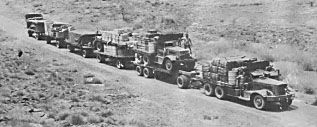The biggest road train in the world
29 November 2011

 Life-line to the tiny mining town of Tennant Creek, Dave Baldock was initially horrified when he first arrived there in search of work in 1934.
Life-line to the tiny mining town of Tennant Creek, Dave Baldock was initially horrified when he first arrived there in search of work in 1934.
However, he couldn’t afford to leave and took a job carting for the general store. By 1937 he’d saved enough money to move to Alice Springs and start his own business.
With two single drive V8 Ford tray trucks Dave began carting freight from the railhead in Alice Springs along the Old Telegraph Line to Tennant Creek.
Times were tough so Dave drove both trucks himself. He would drive the first truck, laden with perishables, to Tennant Creek and then fly back to Alice Springs to drive the second (dry goods) truck to Tennant Creek. He would then return to Alice Springs with the second truck piggy backed on the first.
With the WWII upgrade of the road Dave introduced duel wheeled GMCs to his fleet to haul 23 ton payloads; a feat unheard of just five years previous.
After WWII Dave purchased two ex US Army 200 hp Diamond T 980s at the Army surplus sales.
These trucks were powerful enough to tow seven trailers loaded with around twelve tons each and made for a foreboding sight along the track.
When laden, the truck had to be kept in low gear as it went downhill or the trailers would push the truck forward.
At the next upgrade you’d have to drive at full speed to keep ahead of the gaining momentum of the trailers.
Most of the trailers were made from American Army Bren Gun trailers.
Dave usually hauled general goods to Tennant Creek and carried copper ore back to Alice Springs. The average length of a Baldock roadtrain was 186 metres and they were, without doubt, the biggest in the world at the time.
 In those days, the number of trailers was determined by the power of the truck, the condition of the road and the skill of the driver.
In those days, the number of trailers was determined by the power of the truck, the condition of the road and the skill of the driver.
And, Dave Baldock certainly had the skill. His ingenuity with multi-trailer combinations helped pave the way for the development of the modern roadtrain.
Dave was a Foundation Member of the Road Transport Hall of Fame. He passed away in Adelaide in April 2000.
Story and photos courtesy of the Road Transport Hall of Fame.



Amazing this story did not mention Kurt Johansson, the inventor of the those road trains and the bloke who started the Road Transport Hall of Fame. http://en.wikipedia.org/wiki/Road_train
I drove one of those Diamond T trucks when I worked in Tennant Creek ball dock yard in 1972.
It was a monster of a truck, while I was there the truck’s gear box disintegrated on one of its run to Peko Mine.
On one of the Mack 600 trucks I hauled a hundred ton one day plus I drove a semi and four dogs though the main street of Tennant Creek.
In January 1966, while heading south from Darwin (in my 1960 Holden FB panel van) I followed a road train south of Tennant Creek.
A tandem drive tray top, hauling two trailers. I motored along behind this rig for maybe an hour, while it slogged along at maybe 65 to 70 kph. Way too slow for my Holden with its newly rebuilt engine. The load? Lead concentrates, from Peko mines, in canvas or burlap bags stacked about three high. Not on pallets. Heavily laden. Headed for Alice and the railhead.
Couldn’t overtake with any safety. The then Stuart Highway was about a lane and a half wide. Hot wind and blowing dust. It’s January, and it’s heat and dust. The rear dog trailer swinging around.
Then the wind changed, and I could see ahead. Just. Had the low beams already on, and eased past. The truck, from Tennant Ck, Baldocks Transport Leyland Super Hippo. Yep, these were bonneted trucks.
Oh, also back in the day, you didn’t set off on a long road trip (for me, Darwin to eastern states and return) without a Perspex windshield protector. Way back before laminated screens.